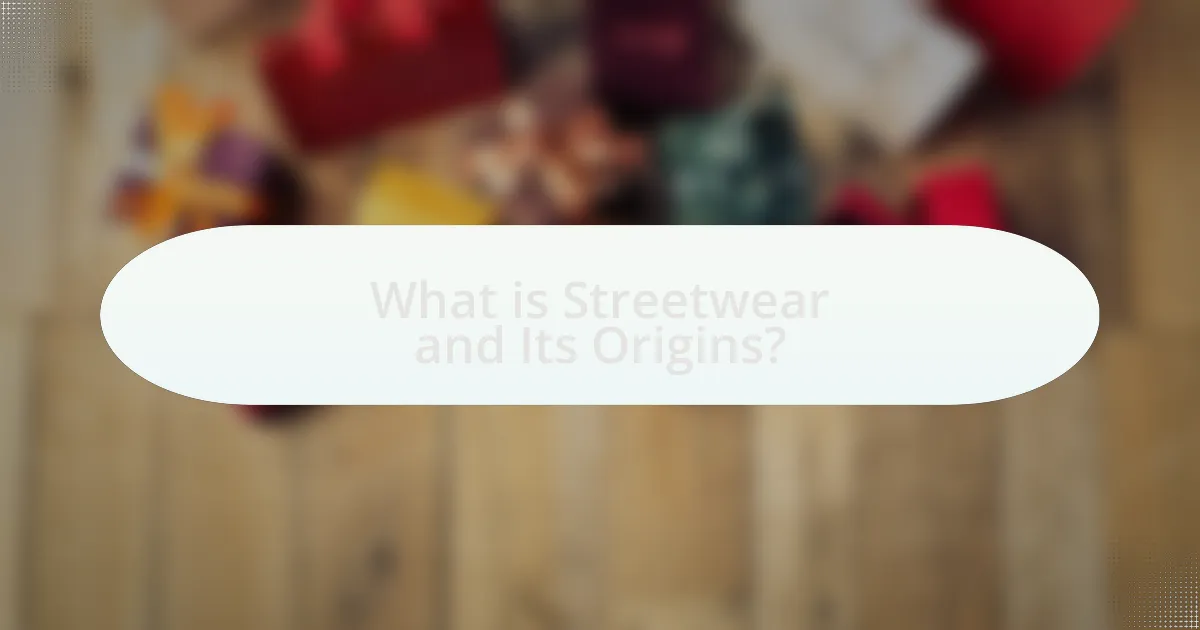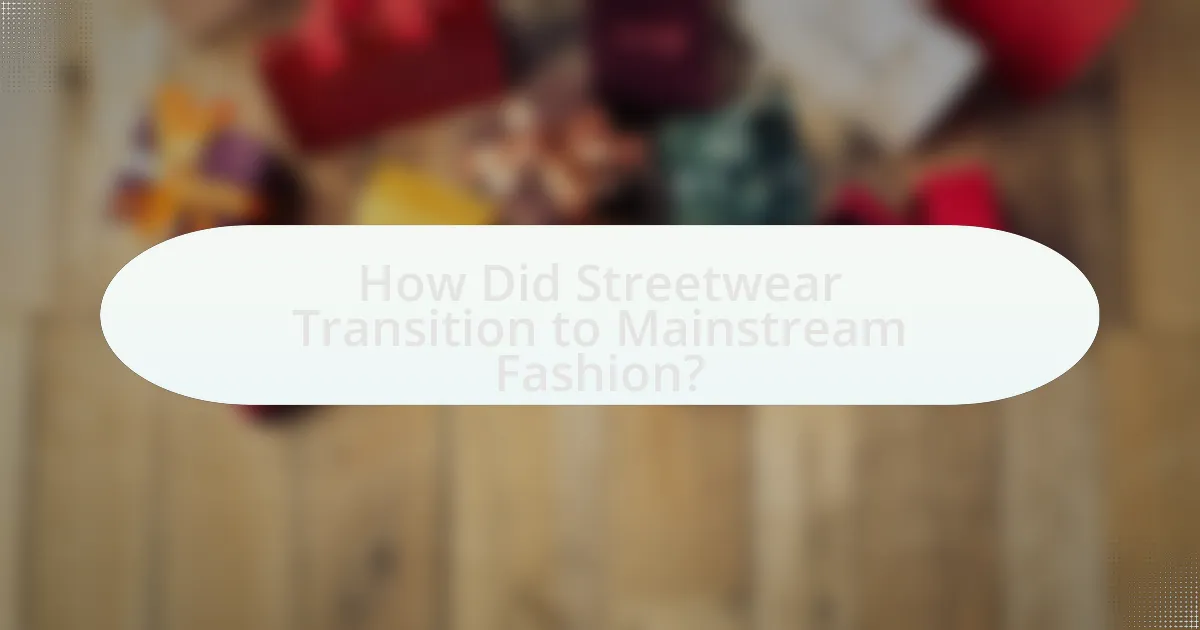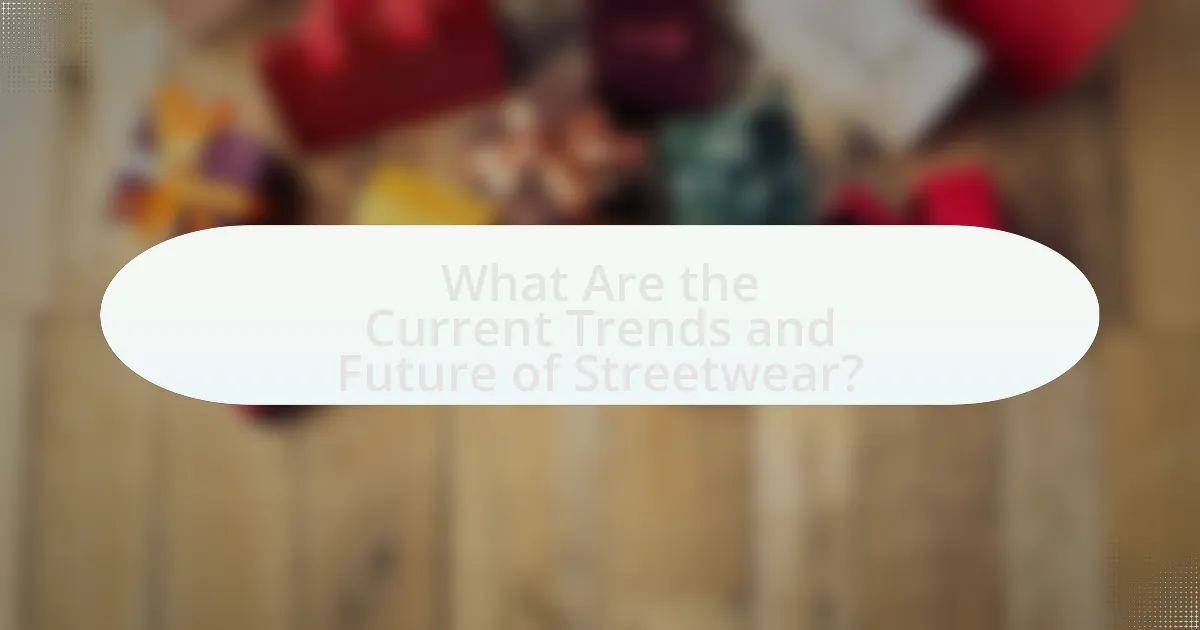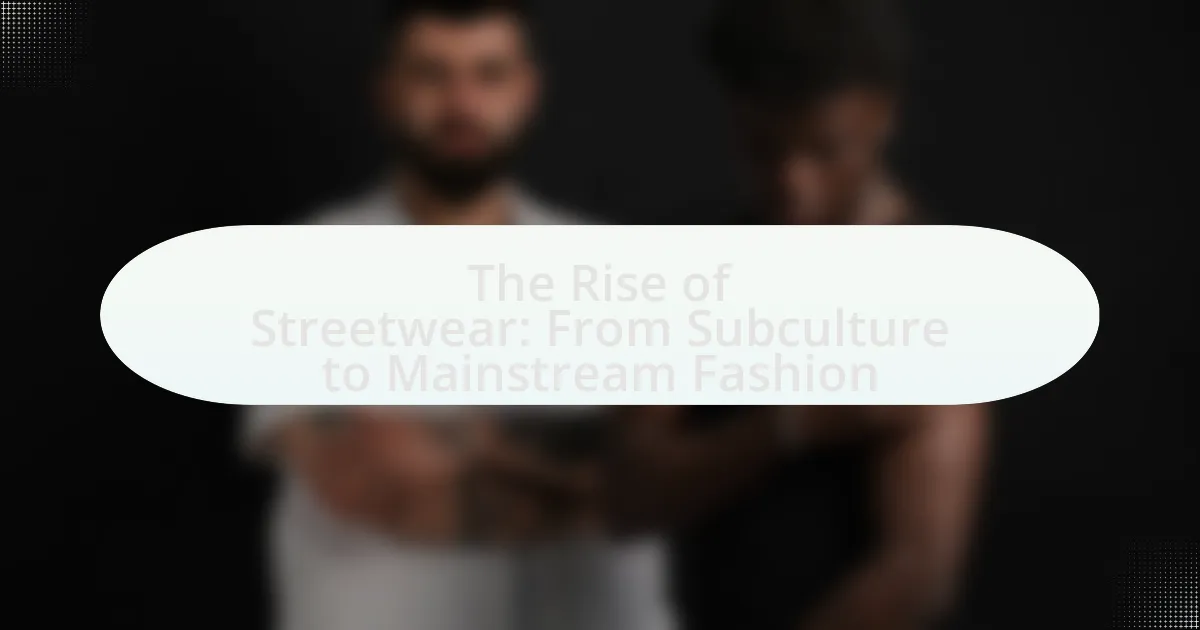Streetwear is a fashion style that originated in California during the late 1970s and early 1980s, influenced by skateboarding, hip-hop, and punk cultures. It emerged as a subculture characterized by casual, comfortable clothing and bold graphics, with key figures like Shawn Stussy and Nigo playing significant roles in its development. The article explores the transition of streetwear from a niche subculture to a mainstream fashion phenomenon, highlighting the impact of celebrity endorsements, social media, and collaborations with luxury brands. Current trends in streetwear include sustainability, gender fluidity, and technological innovations, indicating its ongoing evolution and relevance in the fashion industry.

What is Streetwear and Its Origins?
Streetwear is a fashion style characterized by casual, comfortable clothing often influenced by urban culture, skateboarding, and hip-hop. Its origins trace back to the late 1970s and early 1980s in California, where it emerged from the skate and surf culture, with brands like Stüssy and Supreme playing pivotal roles in its development. Streetwear gained traction as a form of self-expression among youth, blending elements of high fashion with everyday wear, and has since evolved into a global phenomenon, influencing mainstream fashion and culture significantly.
How did streetwear emerge as a subculture?
Streetwear emerged as a subculture in the late 1970s and early 1980s, primarily influenced by skateboarding, hip-hop, and punk cultures. This fusion of styles was characterized by casual, comfortable clothing that often featured bold graphics and logos, reflecting the attitudes and lifestyles of urban youth. The rise of brands like Stüssy and Supreme, which began as small, niche labels, played a significant role in solidifying streetwear’s identity. These brands utilized grassroots marketing and collaborations with artists and musicians, further embedding streetwear into the cultural fabric of cities. The emergence of streetwear was also marked by its association with youth rebellion and self-expression, making it a powerful subculture that resonated with a generation seeking authenticity and individuality.
What cultural influences shaped the early streetwear movement?
The early streetwear movement was shaped by a combination of skate culture, hip-hop, and punk influences. Skate culture introduced casual, functional clothing that prioritized comfort and mobility, while hip-hop contributed bold graphics and a sense of identity through fashion. Punk culture added an element of rebellion and DIY aesthetics, emphasizing individuality and self-expression. These influences coalesced in urban environments during the 1980s and 1990s, leading to the emergence of brands like Stüssy and Supreme, which encapsulated these diverse cultural elements.
Who were the key figures in the development of streetwear?
The key figures in the development of streetwear include Shawn Stussy, Hiroshi Fujiwara, and Nigo. Shawn Stussy, the founder of Stüssy, is often credited with popularizing streetwear in the 1980s by blending surf culture with urban fashion. Hiroshi Fujiwara, known as the “Godfather of Streetwear,” played a crucial role in shaping the genre through his brand, Fragment Design, and collaborations with major labels. Nigo, the creator of A Bathing Ape (BAPE), further propelled streetwear into mainstream fashion in the 1990s with his unique designs and marketing strategies. These individuals significantly influenced the aesthetics and commercialization of streetwear, establishing it as a dominant force in contemporary fashion.
What defines streetwear as a fashion style?
Streetwear is defined as a fashion style characterized by its casual, urban aesthetic that blends elements of skate, hip-hop, and youth culture. This style often features graphic t-shirts, oversized silhouettes, hoodies, sneakers, and accessories that reflect a sense of individuality and self-expression. The origins of streetwear can be traced back to the 1980s and 1990s, particularly in cities like New York and Los Angeles, where it emerged from subcultures and was heavily influenced by street art and music. The rise of brands like Supreme and Off-White has solidified streetwear’s position in mainstream fashion, demonstrating its cultural significance and commercial viability.
What are the key characteristics of streetwear clothing?
Streetwear clothing is characterized by its casual, urban aesthetic, often incorporating elements from skate, hip-hop, and youth culture. This style typically features oversized silhouettes, graphic tees, hoodies, and sneakers, emphasizing comfort and self-expression. Additionally, streetwear often includes limited-edition releases and collaborations with artists or brands, creating a sense of exclusivity and community among wearers. The influence of streetwear has been validated by its adoption by high-fashion designers and its presence in major fashion weeks, demonstrating its transition from a subculture to a significant segment of mainstream fashion.
How does streetwear differ from traditional fashion styles?
Streetwear differs from traditional fashion styles primarily in its emphasis on casual, urban aesthetics and cultural influences rather than formal design and craftsmanship. Traditional fashion often prioritizes high-quality materials, tailored fits, and seasonal trends dictated by fashion houses, while streetwear focuses on comfort, self-expression, and often incorporates elements from youth culture, music, and art. For example, brands like Supreme and Off-White have gained prominence by blending graphic designs and logos with everyday wear, contrasting with the structured silhouettes typical of traditional fashion. This shift reflects a broader cultural movement where streetwear has become a significant influence in mainstream fashion, as evidenced by collaborations between streetwear brands and luxury designers, highlighting its growing acceptance and impact on the fashion industry.

How Did Streetwear Transition to Mainstream Fashion?
Streetwear transitioned to mainstream fashion through a combination of cultural influence, celebrity endorsements, and strategic collaborations. Initially rooted in skate and hip-hop culture, streetwear gained traction in the 1990s with brands like Supreme and Stüssy, which emphasized limited releases and exclusivity. The rise of social media platforms in the 2000s allowed these brands to reach wider audiences, showcasing their unique aesthetics and lifestyle.
High-profile collaborations, such as the partnership between Nike and Off-White, further blurred the lines between streetwear and luxury fashion, attracting attention from both fashion enthusiasts and mainstream consumers. Additionally, fashion weeks began to feature streetwear designers, legitimizing the style within the fashion industry. By 2020, streetwear accounted for a significant portion of the global apparel market, illustrating its acceptance and integration into mainstream fashion.
What factors contributed to the rise of streetwear in mainstream culture?
The rise of streetwear in mainstream culture was primarily driven by the influence of youth culture, celebrity endorsements, and the integration of social media. Youth culture, particularly in urban areas, embraced streetwear as a form of self-expression and identity, leading to its popularity among younger demographics. Celebrity endorsements, such as those from musicians and athletes, further propelled streetwear into the spotlight, making it desirable and aspirational. Additionally, social media platforms like Instagram and TikTok facilitated the rapid dissemination of streetwear trends, allowing brands to reach a global audience quickly. This combination of cultural relevance, celebrity influence, and digital marketing strategies solidified streetwear’s position in mainstream fashion.
How did collaborations between streetwear brands and luxury labels influence this transition?
Collaborations between streetwear brands and luxury labels significantly accelerated the transition of streetwear into mainstream fashion. These partnerships, such as the collaboration between Supreme and Louis Vuitton in 2017, showcased how luxury brands embraced streetwear aesthetics, thereby legitimizing the style within high fashion. This fusion attracted a broader audience, merging the exclusivity of luxury with the accessibility of streetwear, which resulted in increased visibility and demand for streetwear items in high-end retail environments. The success of these collaborations demonstrated that streetwear could command premium prices and appeal to affluent consumers, further solidifying its place in the fashion hierarchy.
What role did social media play in popularizing streetwear?
Social media significantly contributed to the popularization of streetwear by providing a platform for brands and influencers to showcase their styles and connect with a global audience. Platforms like Instagram and TikTok enabled streetwear brands to reach consumers directly, bypassing traditional retail channels. This direct engagement allowed for rapid dissemination of trends and styles, exemplified by the viral success of brands like Supreme and Off-White, which utilized social media marketing strategies to create hype around limited releases. Additionally, user-generated content and influencer partnerships amplified visibility, with influencers showcasing streetwear in their daily lives, further embedding it into mainstream culture. The combination of visual appeal and community engagement on social media platforms transformed streetwear from a niche subculture into a dominant fashion trend.
Why did major fashion brands start adopting streetwear elements?
Major fashion brands started adopting streetwear elements to tap into the growing demand for casual, relatable, and youth-oriented styles. This shift was driven by the rise of street culture and the influence of social media, which allowed brands to connect with younger consumers who prioritize authenticity and individuality in their fashion choices. The global streetwear market was valued at approximately $185 billion in 2021, indicating significant commercial potential. Brands like Gucci and Balenciaga incorporated streetwear aesthetics to remain relevant and appeal to a broader audience, reflecting a cultural shift towards more relaxed and inclusive fashion.
How did consumer demand shape the evolution of streetwear in high fashion?
Consumer demand significantly influenced the evolution of streetwear in high fashion by driving brands to incorporate casual, urban aesthetics into their collections. As consumers increasingly sought comfort and individuality in their clothing, high fashion labels began collaborating with streetwear designers and adopting streetwear elements, such as oversized silhouettes and graphic prints. This shift is evidenced by the success of collaborations like Louis Vuitton’s partnership with Supreme in 2017, which generated over $1 billion in sales, demonstrating the lucrative potential of merging streetwear with luxury fashion. Additionally, the rise of social media platforms allowed consumers to showcase their streetwear styles, further pressuring high fashion brands to adapt to this growing trend.
What impact did celebrity endorsements have on streetwear’s mainstream acceptance?
Celebrity endorsements significantly accelerated streetwear’s mainstream acceptance by leveraging the influence of high-profile figures to legitimize and popularize the style. For instance, endorsements from celebrities like Kanye West and Rihanna have transformed streetwear brands such as Yeezy and Fenty into cultural phenomena, leading to increased visibility and sales. According to a 2019 report by Business of Fashion, collaborations between streetwear brands and celebrities resulted in a 30% increase in brand recognition among target demographics. This phenomenon illustrates how celebrity endorsements not only enhance brand credibility but also bridge the gap between niche subcultures and broader consumer markets, solidifying streetwear’s position in mainstream fashion.

What Are the Current Trends and Future of Streetwear?
Current trends in streetwear include a focus on sustainability, gender fluidity, and collaborations between high fashion and street brands. Brands are increasingly adopting eco-friendly materials and practices, reflecting consumer demand for environmentally responsible fashion. Gender-neutral clothing is gaining popularity, as seen in collections from brands like Off-White and Balenciaga, which cater to a diverse audience. Collaborations, such as those between Nike and designer Virgil Abloh, highlight the blending of streetwear with luxury fashion, further solidifying streetwear’s place in mainstream culture.
The future of streetwear is likely to see continued innovation in technology, such as the integration of augmented reality in shopping experiences and the use of blockchain for authenticity verification. Additionally, the rise of digital fashion and virtual clothing for avatars in online spaces suggests that streetwear will evolve alongside digital platforms, appealing to younger, tech-savvy consumers. As streetwear continues to adapt to cultural shifts and technological advancements, it will maintain its relevance and influence in the fashion industry.
What are the latest trends in streetwear fashion today?
The latest trends in streetwear fashion today include oversized silhouettes, bold graphics, and a blend of high fashion with casual wear. Oversized clothing, such as baggy jeans and large hoodies, has gained popularity, reflecting a shift towards comfort and relaxed styles. Bold graphics, including logos and artistic prints, are prevalent, often seen on t-shirts and outerwear, emphasizing individuality and self-expression. Additionally, collaborations between streetwear brands and luxury fashion houses, like the partnership between Off-White and Nike, illustrate the merging of streetwear with mainstream fashion, further solidifying its presence in the industry.
How are sustainability and ethical practices influencing streetwear brands?
Sustainability and ethical practices are significantly influencing streetwear brands by driving them to adopt eco-friendly materials and transparent supply chains. Many streetwear brands, such as Patagonia and Reformation, have integrated sustainable practices into their business models, focusing on reducing environmental impact and promoting fair labor conditions. For instance, a report by McKinsey & Company highlights that 66% of consumers are willing to pay more for sustainable brands, indicating a market shift towards ethical consumption. This trend compels streetwear brands to innovate in their production processes, leading to increased use of recycled fabrics and ethical sourcing, ultimately reshaping the industry landscape.
What innovations are emerging in streetwear design and production?
Innovations in streetwear design and production include the use of sustainable materials, advanced manufacturing technologies, and digital customization. Sustainable materials, such as recycled fabrics and organic cotton, are increasingly adopted to reduce environmental impact, with brands like Patagonia leading the way. Advanced manufacturing technologies, including 3D printing and automated cutting, enhance efficiency and allow for intricate designs, as seen in collaborations between streetwear brands and tech companies. Digital customization enables consumers to personalize their clothing, exemplified by Nike’s “Nike By You” platform, which allows customers to design their own sneakers. These innovations reflect a shift towards more responsible and consumer-centric practices in the streetwear industry.
How can individuals incorporate streetwear into their personal style?
Individuals can incorporate streetwear into their personal style by blending casual, urban-inspired pieces with their existing wardrobe. This can be achieved by selecting key streetwear items such as oversized graphic tees, hoodies, joggers, and sneakers, which are foundational elements of the style. For example, pairing a graphic tee with tailored trousers can create a balanced look that maintains the relaxed vibe of streetwear while adding sophistication.
Additionally, layering is a common technique in streetwear; individuals can enhance their outfits by adding bomber jackets or denim jackets over their base layers. Accessories like snapback hats, beanies, and statement sneakers can further personalize the look, allowing individuals to express their unique style within the streetwear aesthetic.
The rise of streetwear has been supported by its adoption by high-fashion brands and celebrities, which has made it more accessible and acceptable in various social settings. This trend illustrates that streetwear can be versatile, fitting into both casual and semi-formal occasions, thus encouraging individuals to experiment with their style.
What tips can help someone build a streetwear wardrobe effectively?
To build a streetwear wardrobe effectively, focus on key pieces that define the style, such as oversized tees, hoodies, joggers, and statement sneakers. These items are foundational to streetwear aesthetics, which emphasize comfort and individuality. Incorporating brands known for their streetwear influence, like Supreme, Off-White, and A Bathing Ape, can enhance authenticity. Additionally, layering is crucial; combining different textures and styles creates depth in outfits. Accessorizing with caps, backpacks, and jewelry can also elevate the overall look. Research indicates that streetwear’s popularity surged in the 2010s, with a 2020 report from Statista showing a market value of approximately $185 billion, highlighting the demand for this fashion genre.
How can one stay updated with evolving streetwear trends?
To stay updated with evolving streetwear trends, one should actively follow influential streetwear brands, designers, and fashion publications. Engaging with platforms like Instagram and TikTok allows individuals to see real-time updates from fashion influencers and brands, as these platforms are widely used for trend dissemination. Additionally, subscribing to fashion newsletters and websites such as Hypebeast and Highsnobiety provides curated content on the latest releases and collaborations. Research indicates that social media has become a primary source for fashion trend information, with 54% of consumers using it to discover new styles. By combining these methods, individuals can effectively keep pace with the dynamic nature of streetwear fashion.

Leave a Reply